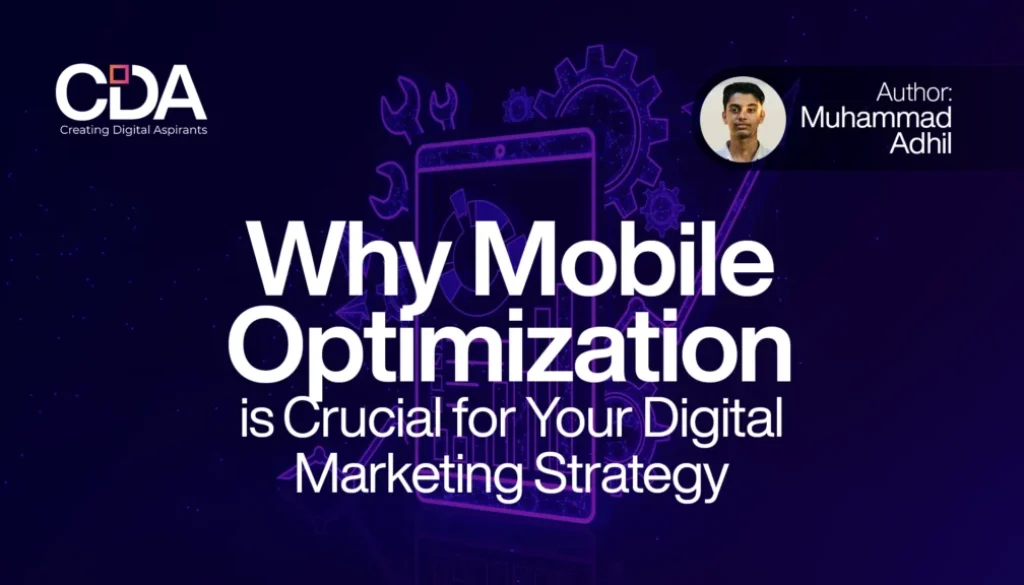Why Mobile Optimization is Crucial for Your Digital Marketing Strategy
In today’s digital world, mobile devices have become the go-to tools for accessing information, making purchases, and engaging with brands. Whether it’s browsing social media, shopping online, or reading the latest blog post, people are increasingly using their smartphones and tablets to interact with the internet. This shift in consumer behavior has made mobile optimization a critical part of any successful digital marketing strategy. A website that isn’t optimized for mobile users can result in missed opportunities, frustrated visitors, and a high bounce rate. In this blog, we’ll explore why mobile optimization is essential for your marketing efforts and how it can help drive engagement, conversions, and customer satisfaction.
Table of Contents
Understanding Mobile Optimization
Mobile optimization refers to the process of designing and coding your website so that it functions well on mobile devices such as smartphones and tablets. This includes ensuring that your website is responsive, loads quickly, and offers an easy-to-navigate user experience, regardless of the device used to access it. In other words, mobile optimization makes sure that visitors on smaller screens have a seamless experience, just as they would on a desktop computer.
With more people using mobile devices to browse the internet than ever before, businesses must make it a priority to create mobile-friendly websites. If your website is difficult to read, navigate, or interact with on a mobile device, you risk losing potential customers and damaging your brand reputation.
The Growing Importance of Mobile Traffic
The importance of mobile optimization cannot be overstated, especially given the increasing amount of web traffic coming from mobile devices. According to studies, mobile internet usage now accounts for over half of all global web traffic, and that number continues to rise. This shift in how consumers access the internet means that businesses can no longer afford to ignore mobile users.
When you optimize your website for mobile, you’re not just improving user experience; you’re also tapping into a larger pool of potential customers. People want to browse, shop, and interact with brands while they’re on the go. If your website isn’t optimized for mobile, you risk alienating this growing group of users who could otherwise become loyal customers.
Impact on User Experience
A smooth user experience is at the heart of any successful website, and mobile optimization plays a crucial role in achieving that. When a website is not mobile-friendly, users often encounter issues like slow loading times, images that don’t load properly, or text that is too small to read without zooming in. These frustrations can lead to a poor user experience, which often results in visitors leaving your site and seeking out a competitor that offers a better experience.
On the other hand, a website that’s optimized for mobile devices ensures that users can easily navigate through your content, view images, and make purchases with minimal effort. A good mobile experience enhances the chances of visitors staying longer on your site and completing their desired actions, whether that’s filling out a contact form, making a purchase, or subscribing to your newsletter.
SEO and Mobile Optimization
Mobile optimization also plays a significant role in your website’s search engine rankings. Google, the most widely used search engine, has moved to a mobile-first indexing system. This means that Google predominantly uses the mobile version of a website to determine its ranking in search results. Websites that are not optimized for mobile may struggle to rank well in search results, even if they perform well on desktop devices.
Moreover, Google has made it clear that site speed and mobile usability are key factors in determining rankings. A slow, non-mobile-friendly website can hurt your SEO efforts and lead to fewer visitors from organic search. Therefore, investing in mobile optimization not only improves user experience but also boosts your site’s visibility on search engines.
Mobile Commerce and Conversion Rates
The rise of mobile commerce (m-commerce) has reshaped the way people shop. With more consumers making purchases from their smartphones, ensuring that your website is optimized for mobile is essential for driving sales. A mobile-friendly website improves the shopping experience by allowing customers to browse products, compare prices, and complete transactions with ease, all from the convenience of their mobile devices.
If your website isn’t optimized for mobile, customers may abandon their shopping carts or opt for a competitor with a more user-friendly site. By providing a smooth mobile shopping experience, you can improve your conversion rates and increase sales. In fact, studies show that mobile-optimized websites tend to have higher conversion rates, as they reduce friction and streamline the purchasing process.
Social Media and Mobile Optimization
Social media plays a significant role in driving traffic to your website, and most social media platforms are accessed via mobile devices. When users click on links shared on social media, they expect to be directed to websites that are easy to navigate on their mobile devices. If your website isn’t optimized for mobile, visitors may leave before engaging with your content or taking any action.
By ensuring that your website is mobile-optimized, you’re better positioned to convert social media traffic into loyal customers. Additionally, providing a mobile-friendly experience encourages users to share your content with their networks, leading to increased brand visibility and potential customers.
Conclusion
Mobile optimization is no longer optional—it’s a necessity for any business that wants to succeed in the digital age. As mobile usage continues to rise, ensuring that your website is mobile-friendly has become a key factor in providing a positive user experience, improving SEO rankings, and boosting conversions. By prioritizing mobile optimization, you’re not only enhancing the customer experience but also giving your brand a competitive edge in a crowded digital marketplace. In today’s mobile-first world, businesses that fail to optimize for mobile risk falling behind. So, take action now to ensure that your website is ready to meet the demands of today’s mobile-driven audience.
Author Info
Adhil, as a digital marketing consultant in Malappuram.
Learner of CDA Digital Marketing Courses in Kerala.




